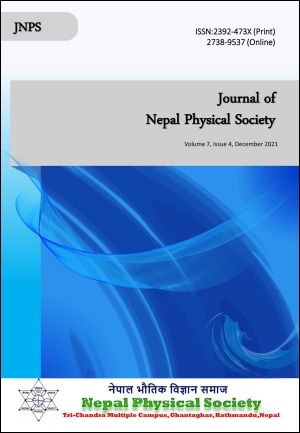Dust Properties of Super-Nova Remnant (Crab Nebula) Using AKARI Survey
DOI:
https://doi.org/10.3126/jnphyssoc.v7i4.42933Keywords:
AKARI, Crab Nebula, Dust Color Temperature, Dust mass, Visual ExtinctionAbstract
We present the distribution of dust color temperature, Planck's function, dust mass, and visual extinction in the far-infrared (140 μm and 90 μm) AKARI surveys of the Crab Nebula using Sky View Virtual Observatory. With a systematic search of a supernova remnants, we found Crab Nebula at R. A. (J2000) / Decl. (J2000) = 05h 34' 31.94"/+22° 00' 52.20". The maximum flux is found to be 145.94 MJysr-1 at 140 μm and 177.01 MJysr-1 at 90 μm wavelength. The total dust mass of the Supernova remnant is estimated to be 6.11×1039 kg (3.07×109 Mʘ) and the dust color temperature is found in the range between 31.16 K to 47.11 K with mean value of temperature of 38.07 K. Similarly we obtained the value of Planck’s function in the range of 3.96 × 10-15 Wm-2sr-1Hz-1 to 1.96 × 10-14 Wm-2sr-1Hz-1 with average value 9.59 × 10-15 Wm-2sr-1Hz-1. The value of visual extinction ranges from 9.21 × 10-14 mag to 2.70 × 10-13 mag with mean value of 1.57 × 10-13 mag. The distribution trend of flux, dust color temperature, and Planck’s function are nearly similar, whereas dust mass and visual extinction follow an inverse relationship with the previous three parameters.
Downloads
Downloads
Published
How to Cite
Issue
Section
License
All right reserved. No part of this Journal may be reproduced in any form or by any electronic or mechanical means, including information storage and retrieval system, without permission in writing from the publisher, except by a reviewer who may quote brief passage in a review. The views and interpretation in this journal are those of author(s) and they are not attributable to the NPS.




